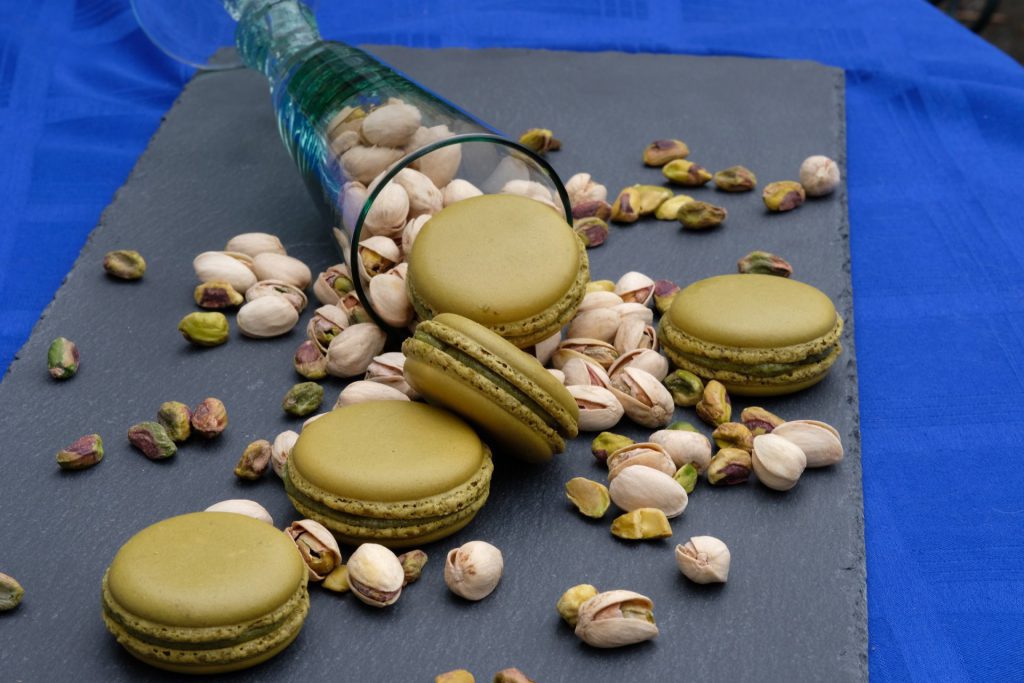French Macarons, Products
Greek Pistachio Macarons
Once upon a time there was a pistachio nut
It is thought that as far back as 9000 years ago, in the Middle East, pistachio nuts were already being consumed and appreciated. Then, they were probably wild fruits. Cultivation of the pistachio tree may have begun as long ago as 4000 years ago in Assyria, in northern Mesopotamia. The Romans introduced it to Europe from Asia in the 1st century and would have contributed to its development. There are many different pistachio species, the most exploited being Pistacia vera, which is believed to originate from Central Asia, particularly desert parts of this region. The tree needs a long hot summer to ripen its fruits and an annual period of cold to induce flowering: conditions specific to deserts.Today, several countries grow pistachio nuts; it has been produced in large quantities in Iran, but also in the USA, in California. Other producers include Turkey, China, Syria and Greece.


Pistachio, the economic gem of Greece
There is a Greek Island called Aegina where pistachios are grown, but Aegina pistachios are not just any pistachios. Declared a Protected Designation of Origin product by the European Union in 1996, the fistiki Aeginis are of the rarer koilarati (round) variety. They have a pale blonde shell, fuschia-tinged exterior and the edible part is emerald green when ripe.
This pistachio has a reputation for excellence. Its first cultivation on the island of Aegina dates back to the end of the 19th century. Some of the islanders dared to abandon their traditional crops to plant trees. In the 1950s and 1960s, farmers cleared their diseased vines and replaced a large area with pistachio trees. In 1975, a special branch of their agricultural cooperative was created for pistachio trees.
The trees and harvesting
Pistachios are dioecious, having separate male and female trees. The fruit is a drupe, containing an elongated seed, which is the edible portion and commonly thought of as a nut. The fruit has a hard, cream-colored exterior shell. The seed has a mauve-coloured skin and light green flesh, with a distinctive flavour. When the fruit ripens, the shell changes from green to an autumnal yellow/red and abruptly splits partly open. This is known as dehiscence, and happens with an audible pop. Commercially grown pistachios vary in how consistently they split open.
The bunches of fruit mature at the end of August and are harvested in late summer or early autumn, as the shells open. Pistachios are now usually picked and sorted mechanically.


The benefits of pistachio nuts
Like many shell fruits (pistachio, almond…) and oleaginous fruits (pecan, walnut…), pistachio nuts contain proteins (26%) and unsaturated fatty acids, mainly monounsaturated ones, which play on the reduction of “bad” cholesterol. They also have protective effects against cardiovascular disease, diabetes, hypertension and cognitive decline. They contain vitamins and minerals, fibres, phytosterols and antioxidants (anthocyanins, vitamin E, lutein, zeaxanthin and resveratrol, known for their multiple positive properties for anti-free radical, anti-cancer, anti-inflammatory health). Pistachio nuts also contain a lot of copper, necessary for the formation of haemoglobin and collagen in the body, as well as for the body’s defence against free radicals.They also provide a good amount of vitamin B6 and iron. Pistachios therefore contribute to the proper functioning of the immune system.They are a source of vitamin B1, necessary for the production of energy, and phosphorus, essential for bones and teeth. Pistachio nuts contain manganese, which facilitates many different metabolic processes, and vitamin K, necessary for the production of proteins that contribute to blood coagulation. But that’s not all! They also contain magnesium, potassium and zinc.


A pistachio straight from a sunny island
For our macarons, we chose pistachios from Aegina, the pistachio island. On this Greek island, pistachio production is not mass production. Aegina is content to produce quality pistachios, which makes them healthy, without artificial fertilizers or GMOs. These pistachios are a Protected Designation of Origin (PDO) product and therefore in great demand all over the world.
And when we say “pistachio” we think of Aegina, the island south of Athens, where the characteristics of the soil and the climate give it a unique taste and aroma.
An Aegina pistachio has a reddish colour and an exquisite taste, far superior to any pistachio you have ever eaten before.



